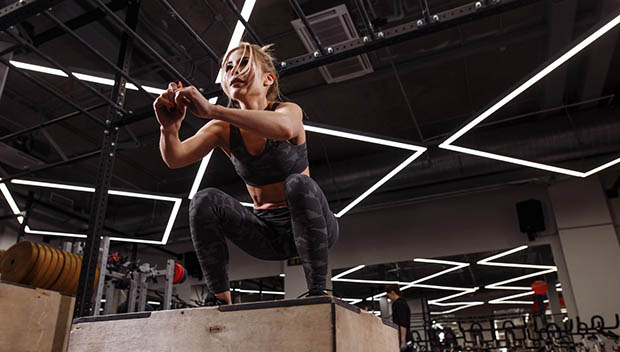
Triathletes can easily get caught up in the swim, bike and run aspect of their training. However, taking a little time away from those disciplines to work on improving strength and mobility can lead to big performance gains. Don’t waste your time with the basic weight circuit at your gym—you don’t need to build endurance in the weight room—instead opt for an efficient mix of high intensity and full body moves. The goal is to challenge and improve upon the training you’re already doing to maximize your race results with improved strength, agility, range of motion and explosive power.
Here are eight key moves that are likely missing from your current routine.
Scorpion Push-Ups
This push up variation works to further engage the glute, core and hips.
- Start in a normal push up position.
- As you lower your arms, bend and lift one leg behind you, rotating your hips up and open.
- Rotate back and return the leg as you push up with your arms.
- Do three sets of five on each leg.
Ice Skaters
Triathletes tend to work the body in only a single plane of movement; front and back. Ignoring your full range of motion can cause injury by ignoring stability issues. This move will engage your core, glutes and thighs while and your heart pumping.
- Start by standing on one leg.
- Push off forcefully to the other side, landing on standing on the other leg.
- As you do this hop, your arms should swing side to side, touching the opposite arm to leg, as if you were speed skating.
- Set a timer and do this for 60 seconds. Repeat additional sets if you can.
Clam Shells
This will seem like a silly addition to any well-trained athlete, but it’s time to lose the ego because this simple move will activate your gluteus medius, a muscle most endurance athletes fail to fully engage.
- Lie on your right side with your feet and hips stacked, knees bent 90 degrees, and head resting on your right arm.
- Keep your abs tight and feet together as you raise your left knee as far as you can without rotating your hip or lifting your right knee off the floor.
- Hold for 1 second, squeezing the glutes and slowly lowering the left knee to the starting position.
- Continue for a total of 20 reps on each side. Adding a resistance band can increase the difficulty.
Swiss Ball Pass
Classic v-ups are an already difficult core move but adding a swiss ball will seriously ramp up this exercise; expect to feel your entire body shaking as you complete this move the first few times!
- Lie on your back squeezing a swiss ball between your feet.
- Bring your legs up (yes, while squeezing the ball) simultaneously rising your chest/upper body up with your arms stretched overhead.
- As your arms and legs meet, grab the ball with your hands and lower your body back to the ground.
- Repeat swapping the ball back and forth.
- Aim to do these until exhaustion.
- Using a smaller or weighted ball can increase intensity.
Box Jumps
You’ll see your sprint improve and transitions become easier after adding this exercise to your routine as it truly develops explosive power.
- Find a sturdy bench, stair or official exercise box.
- Start in the squat position, roughly 6 inches in front of your box.
- Explode up from the low squat onto the top of the box.
- Step backwards down and repeat.
- Aim for 3 sets of 12.
- Adding weights or a taller box will increase difficulty.
Kettlebell Swings
This move is essential for anyone who does CrossFit but somehow gets left out of triathlon training. This squat-swing action works total-body strength, power, explosiveness and balance.
- Stand in a deadlift like stance (weight on the heels, butt lowered) with arms loose while gripping a kettlebell.
- Drive your energy from heels forward through the hips as you swing the bell up.
- The ‘end’ point should be a straight body with hips pushed out slightly and full body engaged (core, glutes, etc. should be TIGHT!). Your arms should swing the weight up chest high. Do not swing the weight higher than your chin.
- Swing back to the starting position in a controlled way.
- Repeat eight to 10 times for two to three sets.
Climber Slide Plank
Most athletes should be able to do a standard plank with little strain. Sure, you could do one for 3-plus minutes, but again, the goal is not endurance. Take your core to the next level. This move will challenge your full body and even get your heart rate up.
- Place both feet on paper plates (or buy ‘slide discs’ or use socks on a slippery floor).
- Get into standard plank form.
- While maintaining plank position (keeping the butt low), slide one foot forward toward hands, crunching your abs.
- Repeat this, alternating feet (like you’re climbing!) for 1 minute.
- Aim for 3 sets.
Single Leg Deadlift
This variation of a deadlift focuses on hinging at the hip to strengthen the back, core and hamstrings. Triathletes can benefit from this move improving balance and posture so long days on the bike and legs will take less of a toll.
- Begin standing with your feet hip-width apart and parallel.
- Lean forward at your hips, shifting your weight onto one leg while your other leg lifts and extends behind you until fully extended.
- Slowly return to the standing position and repeat.
- Aim for three sets of eight to 10.
- Holding weights can make this more difficult.
READ THIS NEXT: Lateral Stability Exercises for Triathletes


